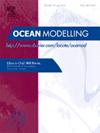Sensitivity analysis of wind drift parameter for lagrangian particle model of dummy drift trajectory in the Northern South China Sea
IF 2.9
3区 地球科学
Q2 METEOROLOGY & ATMOSPHERIC SCIENCES
引用次数: 0
Abstract
In this study, we applied the Lagrangian particle model to simulate the drift trajectories of horizontal dummies in maritime environments, with a specific focus on the northern South China Sea. Wind exerts a force on floating objects, causing them to drift in a direction influenced by the wind direction and strength. The wind drift factor quantifies this effect, indicating how much the wind's force contributes to the overall drift velocity. Sensitivity analysis, employing both the one-at-a-time and Sobol methods, was conducted to examine the model's responses to variations in wind drift parameters. The findings underscore a significant impact of the wind drift factor on the drift trajectory, where an increase in the wind drift coefficient resulted in a gradual deviation of the drift point towards the left, and the overall drift trajectory deviated towards the west. Specifically, when the wind drift coefficient was varied, the model exhibited significant changes in the average drift trajectory and increased instability, as indicated by larger standard deviations. Variations in the depth of wind influence, which pertains to the vertical extent of wind effect on sea surface dynamics, had a relatively smaller impact on the model's output compared to changes in the wind drift factor. These results were further validated by comparing the LPM-simulated trajectories with those predicted by the National Maritime Search and Rescue System. The optimal sea surface wind drift factor, determined through sensitivity experiments, was found to be 0.016, which yielded the most precise simulation of the dummy's drift trajectory.
南海北部伪漂移轨迹拉格朗日粒子模型的风漂移参数敏感性分析
在这项研究中,我们应用拉格朗日粒子模型来模拟海洋环境中水平假人的漂移轨迹,并特别关注南海北部。风对漂浮物施加一个力,使它们在受风向和风力影响的方向上漂移。风漂移因子量化了这种影响,表明风的力量对总漂移速度的贡献有多大。采用单次法和Sobol法进行敏感性分析,以检验模型对风漂参数变化的响应。研究结果表明,风漂因子对漂移轨迹有显著影响,随着风漂系数的增大,漂移点逐渐向左偏移,整体漂移轨迹向西偏移。当风漂移系数变化时,模型的平均漂移轨迹发生显著变化,不稳定性增加,标准差增大。风影响深度的变化与风对海面动力的垂直影响程度有关,与风漂移因子的变化相比,对模式输出的影响相对较小。通过将lpm模拟的轨迹与国家海上搜救系统预测的轨迹进行比较,进一步验证了这些结果。通过灵敏度实验确定的最佳海面风漂移系数为0.016,这是模拟假人漂移轨迹的最精确值。
本文章由计算机程序翻译,如有差异,请以英文原文为准。
求助全文
约1分钟内获得全文
求助全文
来源期刊

Ocean Modelling
地学-海洋学
CiteScore
5.50
自引率
9.40%
发文量
86
审稿时长
19.6 weeks
期刊介绍:
The main objective of Ocean Modelling is to provide rapid communication between those interested in ocean modelling, whether through direct observation, or through analytical, numerical or laboratory models, and including interactions between physical and biogeochemical or biological phenomena. Because of the intimate links between ocean and atmosphere, involvement of scientists interested in influences of either medium on the other is welcome. The journal has a wide scope and includes ocean-atmosphere interaction in various forms as well as pure ocean results. In addition to primary peer-reviewed papers, the journal provides review papers, preliminary communications, and discussions.
 求助内容:
求助内容: 应助结果提醒方式:
应助结果提醒方式:


